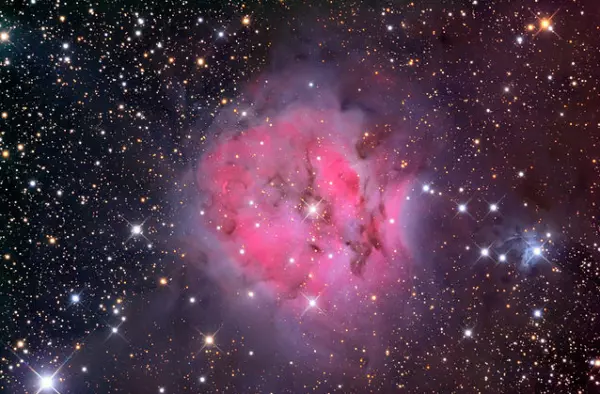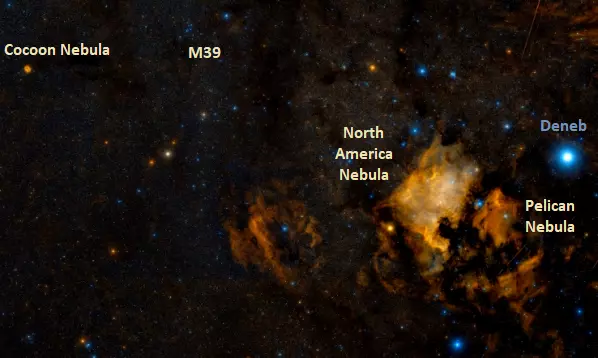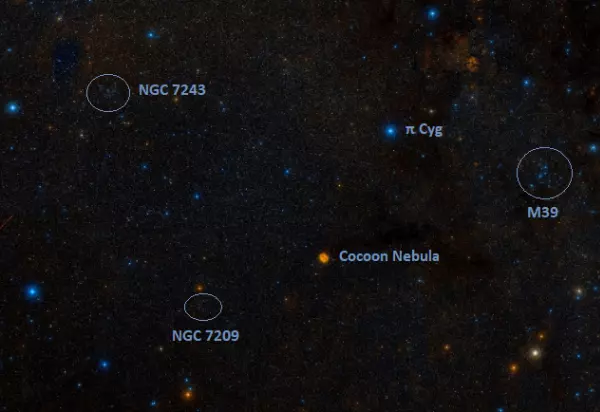The Cocoon Nebula (IC 5146) is a reflection/emission nebula located approximately 2,500 light years away in the constellation Cygnus. With an apparent magnitude of 7.2 and an apparent size of 12 arcminutes, it can be observed in amateur telescopes. Also catalogued as Sh 2-125 and Caldwell 19, the nebula is an active star-forming region associated with the young open cluster Collinder 470.
The Cocoon Nebula is illuminated by BD +46°3474, a hot young main sequence star of the spectral type B0 V or B1 V. The star is enveloped in a molecular cloud at the eastern end of a dark lane spanning 2 degrees. It was reported to be a close binary system in 1987 and may even be a multiple star system. A 2002 study identified it as the most massive member of IC 5146. The star has a mass of 14 ± 4 solar masses and is believed to be only 100,000 years old.
One of the star’s neighbours, catalogued as BD +46°3471, has been identified as a HAeBe variable. HAeBe (Herbig Ae/Be) stars are A- and B-type pre-main sequence stars that are still embedded in clouds of dust and gas and may have circumstellar disks. They show variability in brightness due to planetesimals in the circumstellar disks. BD +46°3471 lies about 10 arcminutes west of BD +46°3474. Both stars are surrounded by clusters of young stars. The estimated median age of these stars is around 1 million years.

Cocoon Nebula (IC 5146), image: Adam Block/Mount Lemmon SkyCenter/University of Arizona (CC BY-SA 3.0 US)
The shape of the Cocoon Nebula has been explained as the result of BD +46°3474 having formed near the surface of the cloud and carved a cavity out of which nebular material is flowing in our direction.
The western part of the nebula is intersected by a dark lane that winds around the young cluster. The dark nebula is catalogued as Barnard 168 (B168). It stretches from the Cocoon Nebula in the direction of the bright open cluster Messier 39.
A 2018 study exploring the internal kinematics of young clusters with ages from 1 to 5 million years identified 115 members of IC 5146, located at a distance of 758 to 809 parsecs (2,472 to 2,639 light years).
In 2008, infrared observations with the Spitzer Space Telescope identified more than 200 young stellar objects in the region of the Cocoon Nebula. These are found both in the emission nebula, where they ionize the surrounding gas, and in the dark patch of nebulosity in the western part of the Cocoon.
Location
The Cocoon Nebula lies in the same area of the sky as Deneb and the open cluster Messier 39. Deneb is easily identified as the bright star at the top of the Northern Cross, a bright asterism that outlines the body of the celestial Swan.

Cocoon Nebula location, image: Wikisky
The Cocoon Nebula lies east of Deneb, just southeast of the multiple star system Pi Cygni. It is located in the same region of the sky as the bright open clusters Messier 39 (mag. 5.5) in Cygnus and NGC 7209 (mag. 7.7) and NGC 7243 (mag. 6.4) in Lacerta.

Cocoon Nebula, Messier 39, NGC 7243 and NGC 7209, image: Wikisky
The best time of year to observe the Cocoon Nebula and other bright deep sky objects in Cygnus is during the month of September, when the constellation is high overhead in the evening sky.
Cocoon Nebula – IC 5146
| Constellation | Cygnus |
| Right ascension | 21h 53m 28.7s |
| Declination | +47° 16′ 01″ |
| Apparent magnitude | 7.2 |
| Apparent size | 12′ |
| Distance | 2,500 ± 100 light years (780 ± 30 parsecs) |
| Names and designations | Cocoon Nebula, Sh 2-125, Caldwell 19, IC 5146, Collinder 470, LBN 424, Min 2-70 |